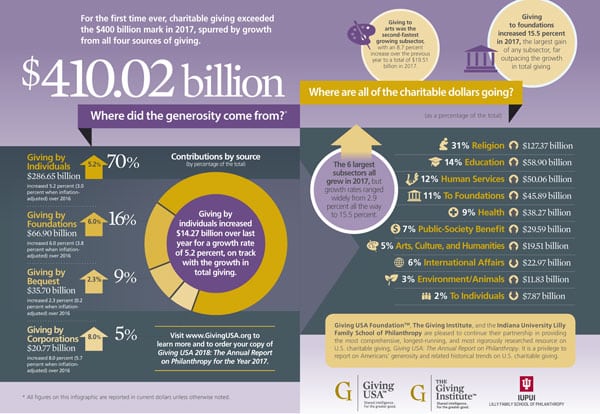
June 26, 2018; Bloomberg Businessweek
According to the Council for Aid to Education, a dozen high-dollar donors accounted for almost one-third of the dollars given to colleges in the last year. At the same time, the percentage of alumni who give has plummeted from 19 percent in 1990 to 7.4 percent last year. What is going on and is it healthy for an institution when its base of supporters grows ever smaller?
This pattern, as we wrote in our piece about the findings of Giving USA, reflects the larger wealth gap in the economy and the increase in very-high-end gifts. As we said in that piece, in each of the last three years, Giving USA has raised the floor on mega-gifts that threw off their report’s algorithms. Three years ago, mega-gifts were defined as those over $100 million; in 2017, they were counted as “mega” only if they hit $300 million or above.
Within charity research, there has been much written on the “crowding out” and “crowding in” effects of government funding. Garth Heutel writes:
Public goods are often provided by both governments and individuals. The interaction of these two sources may affect the overall level of funding. In response to an increase in government spending on a public good or charity, individuals may reduce their contributions. The same effect can occur in the opposite direction. If a government sees that private donations to a charity have risen, then it may reduce its support of that charity. Additionally, some funding may crowd in other funding if it signals charity quality.
Sign up for our free newsletters
Subscribe to NPQ's newsletters to have our top stories delivered directly to your inbox.
By signing up, you agree to our privacy policy and terms of use, and to receive messages from NPQ and our partners.
The wealth divide in the larger economy, of course, appears to have also created a divide in institutions. Less than one percent of the nation’s colleges brought in around 30 percent of the $43.7 billion given to higher education. Harvard and Stanford Universities set records last year by bringing in $1.28 and $1.13 billion respectively. It’s no wonder that more moderately well-off alumni would not see the need to give in the context of individual donations in the hundreds of millions.
Institutions that Raised the Most in 2017
- Harvard University ($1.28 billion)
- Stanford University ($1.13 billion)
- Cornell University ($743.50 million)
- Massachusetts Institute of Technology ($672.94 million)
- University of Southern California ($668.33 million)
- Johns Hopkins University ($636.91 million)
- University of Pennsylvania ($626.49 million)
- Columbia University ($603.08 million)
- Yale University ($595.89 million)
- Duke University ($581.05 million)
- New York University ($567.12 million)
- University of Washington ($553.89 million)
- University of California-Los Angeles ($550.93 million)
- University of Chicago ($483.47 million)
- University of Michigan ($456.13 million)
- University of Notre Dame ($451.43 million)
- University of California-San Francisco ($422.17 million)
- University of California-Berkeley ($404.59 million)
- Ohio State University ($401.85 million)
- Indiana University ($398.26 million)
(Data from the Council for Aid to Education.)
At Harvard, the size of some of the individual donations has been truly mind-boggling of late. In its latest—and now successfully completed—$9 billion campaign, hedge fund manager John Paulson gave an historic $400 million while hedge fund Citadel Advisors’ Ken Griffin gave $150 million. Another $50 million came from investor Len Blavatnik’s Family foundation, and the foundation of Glenn Hutchins of private equity firm Silver Lake gave $30 million.
Not only does this kind of money create the kind of skepticism in Congress that leads to taxes on endowments, but in light of such massive gifts, the money of regular folk just doesn’t seem so important. Bloomberg cites one such case:
Jonathan Hoffman, Harvard class of 1969 and a lawyer in Portland, Ore., says he gave “substantial sums” a decade ago but cut back to $100 a year—and now, nothing—because he didn’t think an institution that pays its endowment managers millions of dollars a year needed his cash. He gives to Room to Read and Habitat for Humanity instead. “There are so many organizations in need,” he says.
Just a thought, but maybe worth some investigation.—Ruth McCambridge











